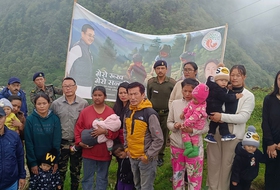
Several hundreds of women in India have rejuvenated vast stretch of forest land through a unique method of guarding the forest.
If effective measures are not implemented, in 20 years rhinos will be extinct in the wild.
In 20 years the only place where we could admire rhinoceroses will be a zoo, imprisoned in cages. A destine that doesn’t do justice to these huge, ancient creatures that have dominated the lands of Eurasia for millions of years.
Humans and rhinos have been sharing the planet for millenniums, as shown in beautiful drawings found in the Chauvet Cave, southern France, dating back to 30,000 years ago. However, rhinos have a dark future ahead, mainly due to poaching. These large herbivores are in fact hunted for their horns, sold at exorbitant costs: 90,000 dollars per kilogramme, a price higher than cocaine.
Rhino’s horns, causing animals to be mutilated and cut, are manly used in Asian traditional medicine since horns are thought to have miraculous properties. However, horns are actually made of keratin, the same material of nails, and any healing property given to them is thus a result of ignorance and popular beliefs lacking of scientific basis.
In 1970, there were over 70,000 rhinoceroses in Africa, whilst today, according to Save the Rhino’s estimates, there are only 20,500 individuals of white rhino and less than 5,000 of black rhino left. If their mortality rate doesn’t decrease – data show that one rhino is killed every 7 hours – in less than 28 years rhinos could be extinct in the wild.
In order to reverse the trend and raise the awareness of governments and public, the WWF established the World Rhino Day, established on 22 September. It has been launched in 2010 by WWF South Africa, and it celebrates the only 5 living species of rhino, two native to Africa and three to Asia, descending from over 30 species that roamed the Earth more than 60 million years ago.
The 5 species left are the white rhinoceros (Ceratotherium simum), the black rhinoceros (Diceros bicornis), the Indian rhinoceros (Rhinoceros unicornis), the Sumatran rhinoceros, and the Javan rhinoceros (Rhinoceros sondaicus).
After its institution, the World Rhino Day has rapidly become a global phenomenon, able to engage NGOs, environmental organisations, businesses, zoos, and people from all around the world.
Several countries adhere to the celberations by organising events and initiatives. Moreover, the viral hashtag on social networks is #worldrhinoday. In order to save rhinos, it is necessary to strengthen protection measures, monitor animals, and forcibly protect the areas destined to wildlife.
The aspect of rhinos hasn’t changed in 20 million years, but the world surrounding them did. There’s only one place where rhino horns must be: on their nose.
Siamo anche su WhatsApp. Segui il canale ufficiale LifeGate per restare aggiornata, aggiornato sulle ultime notizie e sulle nostre attività.
![]()
Quest'opera è distribuita con Licenza Creative Commons Attribuzione - Non commerciale - Non opere derivate 4.0 Internazionale.
Several hundreds of women in India have rejuvenated vast stretch of forest land through a unique method of guarding the forest.
The solution developed by the Italian startup Agri-E enables on-site bioethanol production, promoting energy self-sufficiency for farms.
South African court dismisses a major lawsuit by 140,000 Zambian women and children against Anglo American for Kabwe lead poisoning. A setback for affected communities enduring the lasting impact of lead contamination.
Controversial African land deals by Blue Carbon face skepticism regarding their environmental impact and doubts about the company’s track record, raising concerns about potential divergence from authentic environmental initiatives.
Majuli, the world’s largest river island in Assam State of India is quickly disappearing into the Brahmaputra river due to soil erosion.
Food imported into the EU aren’t subject to the same production standards as European food. The introduction of mirror clauses would ensure reciprocity while also encouraging the agroecological transition.
Sikkim is a hilly State in north-east India. Surrounded by villages that attracts outsiders thanks to its soothing calmness and natural beauty.
Sikkim, one of the smallest states in India has made it mandatory for new mothers to plant saplings and protect them like their children to save environment
Chilekwa Mumba is a Zambian is an environmental activist and community organizer. He is known for having organized a successful lawsuit against UK-based mining companies.







